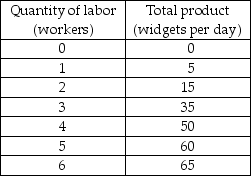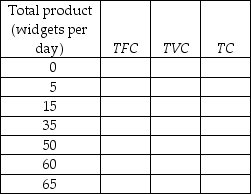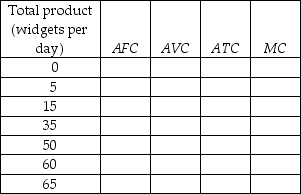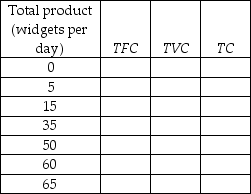


-The first table above has the total product schedule for an imaginary good called a widget. Each unit of labor costs $25 and the total cost of capital is $100.
a) Use this information to complete the remaining two tables. In the tables, TFC is the total fixed cost, TVC is the total variable cost, TC is the total cost, AFC is the average fixed cost, AVC is the average variable cost, ATC is the average total cost, and MC is the marginal cost. 
 b) Suppose that labor becomes twice as expensive (so that one unit of labor now costs $50) but nothing else changes. Complete the above tables with the new cost schedules. If you plotted the cost curves, how would the increased wage rate affect the cost curves?
b) Suppose that labor becomes twice as expensive (so that one unit of labor now costs $50) but nothing else changes. Complete the above tables with the new cost schedules. If you plotted the cost curves, how would the increased wage rate affect the cost curves?
Definitions:
Past Experience
Previous events or interactions that influence an individual's beliefs, behaviors, and attitudes.
Bias
A predisposition or preference towards a particular perspective, ideology, or individual, often leading to unfairness or discrimination.
Peers
Individuals of similar status or position within a specific context, often referring to colleagues or classmates.
Intelligence
The capacity to acquire and apply knowledge, understanding, and reasoning, including problem-solving skills and the ability to adapt to new situations.
Q5: Which of the following factors is fixed
Q28: How do we calculate average fixed cost
Q34: Use the data in the table above
Q119: Which of the following is NOT an
Q182: The cost of a variable input, such
Q204: Suppose there are five firms in the
Q283: What is an incentive system?
Q340: Which of the following is a macroeconomic
Q347: A company needs to know the price
Q424: If marginal cost is less than average